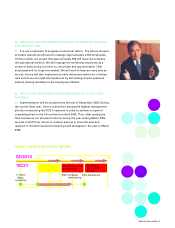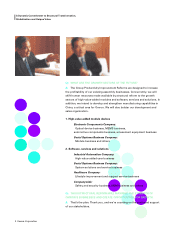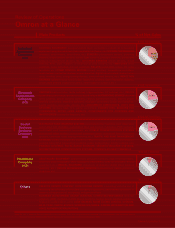Omron 2002 Annual Report Download - page 19
Download and view the complete annual report
Please find page 19 of the 2002 Omron annual report below. You can navigate through the pages in the report by either clicking on the pages listed below, or by using the keyword search tool below to find specific information within the annual report.
TOPICS
REDUCTION OF ENVIRONMENTAL IMPACT
Reduction of CO2Emissions
Omron’s goal is to reduce carbon dioxide emissions 11
percent by 2010, compared with levels in the year ended
March 1996. The company also sets CO2emission targets
for each fiscal year.
In the year ended March 2002, the target for the total
volume of CO2emissions was 12,430 ton-C, a 4.3 percent
reduction compared with the year ended March 1996. The
actual result was 11,747 ton-C, a 9.5 percent reduction.
However, CO2emissions per unit of production increased by
10 percent from the previous fiscal year due to lower
business volume.
Wastes and Recycling
In the year ended March 2002, Omron’s targets were a
recycling rate of 87.5 percent and a final disposal rate of 9.5
percent. Actual results were a recycling rate of 92.0 percent
and a final disposal rate of 4.9 percent, surpassing the
original targets for the year ending March 2006. Total
emission volume was 4,015 tons, a 22 percent decrease
from the previous fiscal year. In addition, OMRON Iida Co.,
Ltd. became the second site, after the Mishima Office, to
achieve zero emissions. Nine domestic manufacturing sites
are expected to achieve zero emissions by the end of the
current fiscal year.
REDUCTION OF HAZARDOUS CHEMICAL SUBSTANCES
Construction of Database for Regulated Chemical
Substances
To reduce hazardous chemical substances contained in
products, Omron constructed a system for gauging the
chemical substances in purchased components, materials
and other items.
Lead-Free Technology
Centered on lead-free technology projects, we have
achieved progress in establishing construction and mass-
production technologies for lead-free soldering and plating,
standardizing reliability assessments and optimizing our
production network. In the year ended March 2002, results
proving the validity of lead-free soldering and plating
technologies were confirmed for 42 products.
INTRODUCTION OF AN ENVIRONMENTAL ACCOUNTING
SYSTEM
An environmental accounting system is a tool that is
intended to monitor and survey the costs (investments and
expenses) associated with environmental activities and
resulting benefits. It serves as an important tool to support
management decision-making in the disclosure of
environmental information. Environmental accounting was
implemented in the Industrial Automation Company in the
previous fiscal year, and was extended to all internal
business companies in the year ended March 2002.
Evaluation of Environmental Indicators:
● Return on Investment: 14% (Financial gain/
Environmental costs)
● Percentage of Eco-Product Sales: 17%
(Eco-Product sales/Total new product sales)***
*** New products are newly developed or designed products that have
gone on sale within the last three years.
Omron Corporation 17
CREATION OF ECO-PRODUCTS
Omron has been promoting the creation of eco-products
since it established the ISO 14021-based “Eco-Product
Approval System” in 1998. In the year ended March 2002, 18
products were approved, bringing the total to 72 products
since 1998.
GREEN PROCUREMENT
Purchasing Green Parts and Materials
Using Omron’s green procurement standards, we
conducted preliminary evaluations of 543 suppliers. From
April 2003, we plan to give purchasing preference to
suppliers rated high in terms of environmental conservation
effort, in addition to such conventional criteria as quality,
price and delivery schedule.
Purchasing Green Indirect Materials
In addition to the procurement of green parts and
materials for use in products, Omron is promoting the
purchase of green indirect materials such as office supplies,
PCs and copy paper. The green product purchase rate** for
10 offices and laboratories reached 74 percent on a value
basis.
Evaluating environmental
impact of a product during
the design stage.
Enhancing logistic efficiency.
Improving packaging
materials and containers.
Purchasing green
parts/materials from
environmentally
conscious suppliers.
Promoting energy
and resource
conservation along with
reduction of waste
and chemical emissions.
Encouraging
the sale and use
of Eco-Products.
Recycling of ATMs
and other products.
Product
Assessment
Marketing
&
Usage
Distribution
Manufacturing
ProcurementRecycling
Products Technologies
Eco-Management
Implementing ecologically conscious management
practices through environmental commitment in
the corporate management system.
Environmental Performance
To reduce the environmental impact of its corporate
activities, Omron is committed to eco-friendly product
development, energy and resource conservation,
reduction of waste, and recycling.
























